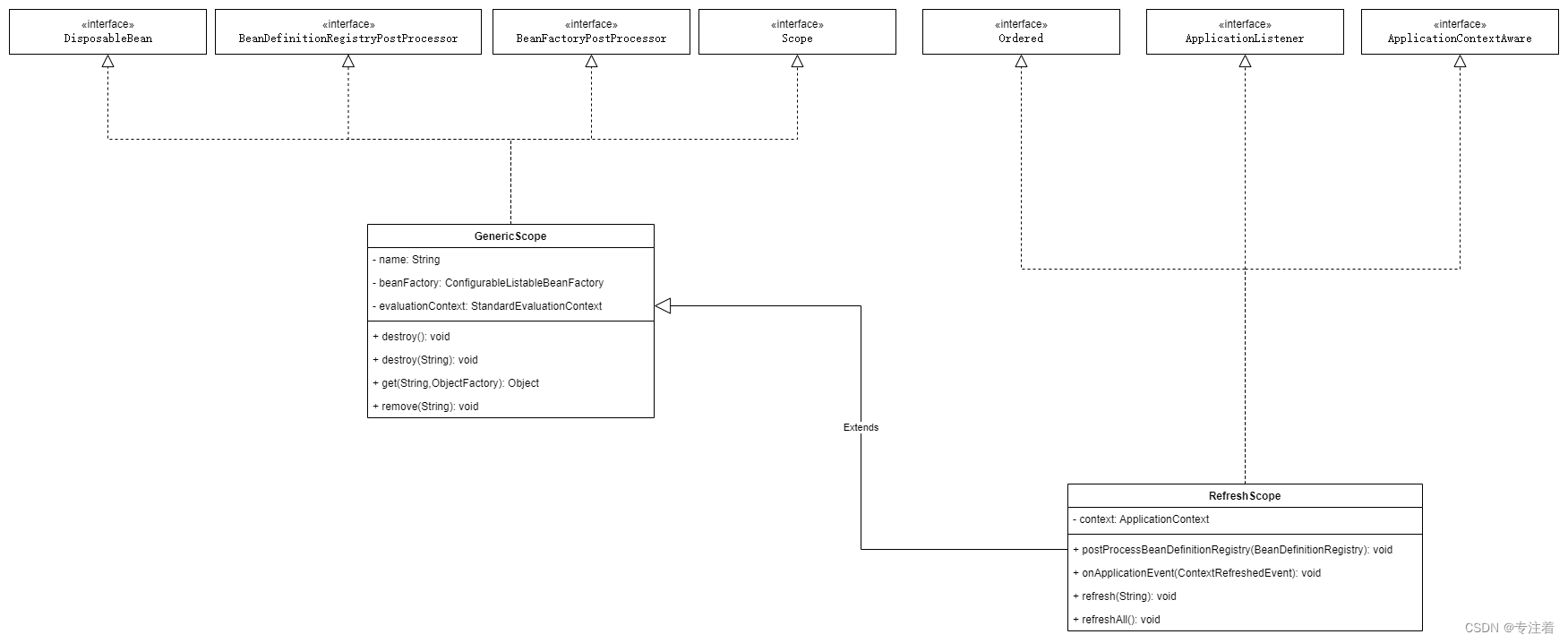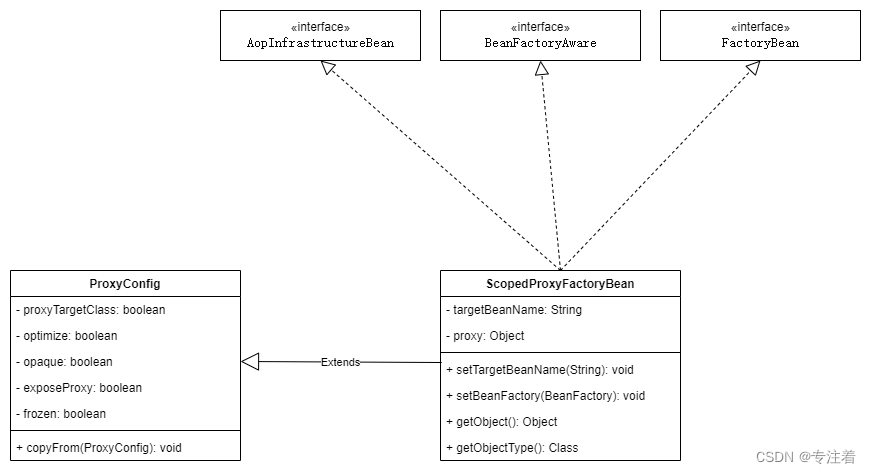在spring cloud alibaba nacos的配置中,我们为了能够实现配置的动态刷新,@RefreshScope则是其中的一个解决方案。这篇文章将会从被@RefreshScope标记的bean从类信息搜集、创建、使用、刷新、销毁这样一个过程入手,记录Scope在spring中的工作原理。
1. @RefreshScope使用方式
@Getter
@Service
@RefreshScope
public class NacosValueService {
@Value("${config.age}")
private Integer age;
private volatile boolean isStop = false;
@PreDestroy
public void destroy() {
System.out.println("执行destroy方法");
}
}通过在类上使用@RefreshScope注解,就能够实现当配置config.age在发生变化之后,bean中的配置信息也会发生变化。
2. @RefreshScope类信息BeanDefinition创建
2.1 RefreshScope注解定义
@Target({ ElementType.TYPE, ElementType.METHOD })
@Retention(RetentionPolicy.RUNTIME)
@Scope("refresh")
@Documented
public @interface RefreshScope {
/**
* @see Scope#proxyMode()
* @return proxy mode
*/
ScopedProxyMode proxyMode() default ScopedProxyMode.TARGET_CLASS;
}在该注解定义中,包含了两种信息:
- 该注解上除了定义注解的使用方式外,还加了一个
@Scope注解,该注解定义了@Scope的名称,常用的有:- singleton
- prototype
- 另外就是代理的方式,因此我们可以推断,最终被
@RefreshScope标记的bean, 最终是一个代理对象。
2.2 获取BeanDefinition
在spring-boot环境中,当执行Application的时候,回去扫描当前classpath下的所有class文件,并将对应的文件解析为对应的BeanDefinition对象。
这里只考虑默认的扫描路径,不考虑通过注解或者配置方式扫描其他路径的情况
2.2.1 ClassPathBeanDefinitionScanner
该类主要为了扫描classpath下的类列表,并将对应的class文件解析为BeanDefinition对象,我们主要查看针对Scope注解对BeanDefinition影响的这部分。其他的不在讨论范围。
doScan()
protected Set<BeanDefinitionHolder> doScan(String... basePackages) {
Assert.notEmpty(basePackages, "At least one base package must be specified");
Set<BeanDefinitionHolder> beanDefinitions = new LinkedHashSet<>();
for (String basePackage : basePackages) {
// 获取路径下的所有BeanDefinition列表
Set<BeanDefinition> candidates = findCandidateComponents(basePackage);
// 遍历所有的BeanDefinition
for (BeanDefinition candidate : candidates) {
// 解析@Scope注解中的内容, 以ScopeMetadata表示
ScopeMetadata scopeMetadata = this.scopeMetadataResolver.resolveScopeMetadata(candidate);
// 更新BeanDefinition的scope值,默认为singleton
candidate.setScope(scopeMetadata.getScopeName());
// 生成beanName, 这里的beanName主要有两种获取方式:
// 1. 判断是否有注解,其中包含了Component, Service, Named, Indexed等注解,如果有,则判断是否设置value值,如果设置,则以value的值为beanName
// 2. 如果以上条件不满足,则去class的名成,只取类名,并将首字母转换为小写
String beanName = this.beanNameGenerator.generateBeanName(candidate, this.registry);
// 这里判断是否为AbstractBeanDefinition类型,如果是,则为BeanDefinition设置必要的参数, 包括初始化方法名称等。
// 不过在默认中,使用的都没有名缺的指定
if (candidate instanceof AbstractBeanDefinition) {
postProcessBeanDefinition((AbstractBeanDefinition) candidate, beanName);
}
// 判断是否为AnnotatedBeanDefinition对象,如果是,则执行通用的注解解析和使用:
// 主要包含了以下几类注解:
// Lazy, Role, Primary, DependsOn, Description
if (candidate instanceof AnnotatedBeanDefinition) {
AnnotationConfigUtils.processCommonDefinitionAnnotations((AnnotatedBeanDefinition) candidate);
}
// 检查BeanDefinition是否已经被注册,如果被注册,则检查两者
if (checkCandidate(beanName, candidate)) {
BeanDefinitionHolder definitionHolder = new BeanDefinitionHolder(candidate, beanName);
// 处理ScopeProxyMode属性配置, 并生成新的DefintionHolder对象
definitionHolder =
AnnotationConfigUtils.applyScopedProxyMode(scopeMetadata, definitionHolder, this.registry);
// 加入beanDefinition列表
beanDefinitions.add(definitionHolder);
// 注册当前FactoryBean的Definition到Regsitry中
registerBeanDefinition(definitionHolder, this.registry);
}
}
}
return beanDefinitions;
}在处理BeanDefinition数据中,最后通过AnnotationConfigUtils.applyScopedProxyMode()方法对BeanDefinition进行处理,在这个过程中,如果当前的BeanDefinition并非为NO时,这个时候在BeanDefinitionRegsitry中包含了两个BeanDefinition, 因此需要特别注意。
- 当
ProxyMode=TARGET_CLASS时,这个时候被代理的BeanDefintion的名称为scopedTarget.${origianlBeanName} - 另一个就是本身的
BeanDefinition, 这时是一个FactoryBean的实现类,则对应的名称为originalBeanName.
所以这两者其实是一个替代关系,代理的FactoryBean指向了被代理的Bean.
2.2.2 AnnotationConfigUtils
该类主要是对注解配置类的解析,其中applyScopedMode()方法解决了不同代理的处理方式,具体源码如下:
createScopedProxy()
public static BeanDefinitionHolder createScopedProxy(BeanDefinitionHolder definition,
BeanDefinitionRegistry registry, boolean proxyTargetClass) {
// 获取初始beanName
String originalBeanName = definition.getBeanName();
// 获取BeanDefinition
BeanDefinition targetDefinition = definition.getBeanDefinition();
// 获取targetBeanName, 这里格式为: ``scopedTarget.${originalBeanName}``
String targetBeanName = getTargetBeanName(originalBeanName);
// Create a scoped proxy definition for the original bean name,
// "hiding" the target bean in an internal target definition.
// 这里是为初始的BeanDefinition创建一个代理,隐藏目标的BeanDefinition
RootBeanDefinition proxyDefinition = new RootBeanDefinition(ScopedProxyFactoryBean.class);
proxyDefinition.setDecoratedDefinition(new BeanDefinitionHolder(targetDefinition, targetBeanName));
proxyDefinition.setOriginatingBeanDefinition(targetDefinition);
proxyDefinition.setSource(definition.getSource());
proxyDefinition.setRole(targetDefinition.getRole());
// 设置TargetBeanName属性,则指向了``scopedTarget.${originalBeanName}``BeanDefinition
proxyDefinition.getPropertyValues().add("targetBeanName", targetBeanName);
if (proxyTargetClass) {
// 如果ProxMode为TARGET_CLASS, 则设置属性'org.springframework.aop.framework.autoproxy.AutoProxyUtils.preserveTargetClass=true'
targetDefinition.setAttribute(AutoProxyUtils.PRESERVE_TARGET_CLASS_ATTRIBUTE, Boolean.TRUE);
// ScopedProxyFactoryBean's "proxyTargetClass" default is TRUE, so we don't need to set it explicitly here.
}
else {
// 如果是其他的,则设置proxyTargetClass为false
proxyDefinition.getPropertyValues().add("proxyTargetClass", Boolean.FALSE);
}
// Copy autowire settings from original bean definition.
// 从源BeanDefinition中拷贝属性
proxyDefinition.setAutowireCandidate(targetDefinition.isAutowireCandidate());
proxyDefinition.setPrimary(targetDefinition.isPrimary());
if (targetDefinition instanceof AbstractBeanDefinition) {
proxyDefinition.copyQualifiersFrom((AbstractBeanDefinition) targetDefinition);
}
// The target bean should be ignored in favor of the scoped proxy.
targetDefinition.setAutowireCandidate(false);
targetDefinition.setPrimary(false);
// Register the target bean as separate bean in the factory.
// 这里需要注意,我们实际的beanName名称是自定义或者指定,但是我们这里处理完成了之后
// 这里就变成了``scopedTarget.${originalBeanName}``, 因此注册的bean名称发生了改变
registry.registerBeanDefinition(targetBeanName, targetDefinition);
// Return the scoped proxy definition as primary bean definition
// (potentially an inner bean).
// 返回代理之后的BeanDefinition信息
return new BeanDefinitionHolder(proxyDefinition, originalBeanName, definition.getAliases());
}3. RefreshScope管理Bean
在讲到对scope=refresh这类的BeanDefinition进行实例化的时候,需要讲到的一个知识点就是对这类Bean的管理。我们知道, Spring默认管理两类bean, 分别为scope=singleton和scope=prototype两类,我们从bean的实例化过程就可以看出。而针对这两类,其他的scope的bean则通过scope类型进行管理,因此,针对scope=refresh的管理,有专门的RefreshScope来实现。
我们查看spring创建bean的过程中,scope的使用如下:
String scopeName = mbd.getScope();
if (!StringUtils.hasLength(scopeName)) {
throw new IllegalStateException("No scope name defined for bean '" + beanName + "'");
}
Scope scope = this.scopes.get(scopeName);
if (scope == null) {
throw new IllegalStateException("No Scope registered for scope name '" + scopeName + "'");
}
try {
Object scopedInstance = scope.get(beanName, () -> { ...从代码中,可以看出,主要包含以下步骤:
- 获取当前
BeanDefinition原信息的scope的值,并根据scope的值获取对应的Scope对象 - 如果
Scope对象不存在,则抛出异常 - 根据
Scope对象的get方法创建bean对象实例。
3.1 类结构
[caption id="" align="alignnone" width="1751"]
3.2 注册时机
从以上的类结构图可以知道,因为GenericScope本身实现了BeanFactoryPostProcessor类,因此在BeanFactory准备完毕后,就会实例化该类并回调函数。因此我们查看对应的实现方法。
public void postProcessBeanFactory(ConfigurableListableBeanFactory beanFactory) throws BeansException {
this.beanFactory = beanFactory;
beanFactory.registerScope(this.name, this);
setSerializationId(beanFactory);
}可以得知,在postProcessBeanFacotry()方法回调方法中,通过regsiterScope()方法将RefreshScope对象注册到BeanFactory对象中,因此在创建Bean的时候能够通过RefreshScope进行管理。
4. 创建Bean
在上面我们讲到了,只要对应的BeanDefintion的scope不是singleton或者prototype时,都会通过Scope对象来管理bean,具体代码如下:
// 获取scope
String scopeName = mbd.getScope();
if (!StringUtils.hasLength(scopeName)) {
throw new IllegalStateException("No scope name defined for bean '" + beanName + "'");
}
// 根据scope,获取对应的Scope对象
Scope scope = this.scopes.get(scopeName);
// 如果没有注册Scope类型,将抛出错误
if (scope == null) {
throw new IllegalStateException("No Scope registered for scope name '" + scopeName + "'");
}
try {
// 从Scope中获取bean对象,如果bean对象不存在,则通过函数创建bean
Object scopedInstance = scope.get(beanName, () -> {
beforePrototypeCreation(beanName);
try {
return createBean(beanName, mbd, args);
}
finally {
afterPrototypeCreation(beanName);
}
});
beanInstance = getObjectForBeanInstance(scopedInstance, name, beanName, mbd);
}
catch (IllegalStateException ex) {
throw new ScopeNotActiveException(beanName, scopeName, ex);
}4.1 工厂类(FactoryBean)初始化
在上面我们谈到,当我们的类需要做类型代理的时候,则会生成两个BeanDefinition对象,因此originalBeanName则被FactoryBean所代替。在代理中,实际上使用的是ScopedProxyFactoryBean进行代替。
ScopedProxyFactoryBean
这个类实现是很简单的,首先该类的类结构如下:
[caption id="" align="alignnone" width="871"]
该类的实现是比较简单的,主要包含了两个元素:
targetBeanName: 被代理的bean名称,之前我们知道,实在bean名称前多加了一个targetBeanName.的前缀proxy:被代理bean对象的实例。
从初始化角度来说,该FactoryBean并没有太多需要设置的内容。
4.2 代理对象proxy何时创建?
我们都知道,代理对象在最终获取被代理对象的时候,都是通过getObject()方法来获取,那么我们通过查看源码,ScopedProxyFactoryBean的 proxy对象的创建,则是放在了setBeanFacotory()方法中。
public void setBeanFactory(BeanFactory beanFactory) {
// 判断beanFactory是否为ConfigurableBeanFacotry的实例
if (!(beanFactory instanceof ConfigurableBeanFactory)) {
throw new IllegalStateException("Not running in a ConfigurableBeanFactory: " + beanFactory);
}
ConfigurableBeanFactory cbf = (ConfigurableBeanFactory) beanFactory;
// scopedTargetSource默认为SimpleBeanTargetSource, 这里绑定了BeanFactory
this.scopedTargetSource.setBeanFactory(beanFactory);
// 创建ProxyFactory实例
ProxyFactory pf = new ProxyFactory();
// 从当前的ProxyConfig拷贝属性值到ProxyFactory中
pf.copyFrom(this);
// 设置被代理对象的信息
pf.setTargetSource(this.scopedTargetSource);
Assert.notNull(this.targetBeanName, "Property 'targetBeanName' is required");
// 获取被代理对象的Class类型
Class<?> beanType = beanFactory.getType(this.targetBeanName);
// 如果beanType为空, 那么对应的bean的class没有被加载到BeanFactory中,则抛出异常
if (beanType == null) {
throw new IllegalStateException("Cannot create scoped proxy for bean '" + this.targetBeanName +
"': Target type could not be determined at the time of proxy creation.");
}
// 判断是否为为代理目标对象,即判断proxyTargetClass属性值是否为false
// 判断代理对象的类型是否为接口
// 判断代理对象的类型定义是否为private
// 当以上条件满足一个时,那么就获取代理对象class的所有接口,并绑定到ProxyFactory对象中
if (!isProxyTargetClass() || beanType.isInterface() || Modifier.isPrivate(beanType.getModifiers())) {
pf.setInterfaces(ClassUtils.getAllInterfacesForClass(beanType, cbf.getBeanClassLoader()));
}
// Add an introduction that implements only the methods on ScopedObject.
// 创建DefaultScopedObject对象,
ScopedObject scopedObject = new DefaultScopedObject(cbf, this.scopedTargetSource.getTargetBeanName());
// 向ProxyFacotry中新增DelegatingIntroductionInterceptor拦截器
pf.addAdvice(new DelegatingIntroductionInterceptor(scopedObject));
// Add the AopInfrastructureBean marker to indicate that the scoped proxy
// itself is not subject to auto-proxying! Only its target bean is.
pf.addInterface(AopInfrastructureBean.class);
// 创建代理对象并绑定到proxy属性中
this.proxy = pf.getProxy(cbf.getBeanClassLoader());
}通过代码可知,创建代理对象是通过ProxyFactory来完成的。
4.3 代理对象proxy创建过程
代理对象的创建主要通过ProxyFactory对象来完成,则查看对应的源码:
getProxy()
public Object getProxy(@Nullable ClassLoader classLoader) {
return createAopProxy().getProxy(classLoader);
}该创建proxy主要通过createAopProxy()方法创建的类来实现。
createAopProxy()
protected final synchronized AopProxy createAopProxy() {
if (!this.active) {
activate();
}
return getAopProxyFactory().createAopProxy(this);
}getAopProxyFactory()方法创建了工厂类对象,这里使用了DefaultAopProxyFactory类来作为默认的工厂类对象。我们知道,spring有两种代理方式:
- JDK Proxy
- 代理class是接口
- 是Proxy生成的代理class
- 是lambda表达式class
- Cglib
这两种方式有不同的选择场景,则对应createAopProxy()代码如下:
public AopProxy createAopProxy(AdvisedSupport config) throws AopConfigException {
if (!NativeDetector.inNativeImage() &&
(config.isOptimize() || config.isProxyTargetClass() || hasNoUserSuppliedProxyInterfaces(config))) {
// 获取被代理对象的class
Class<?> targetClass = config.getTargetClass();
if (targetClass == null) {
throw new AopConfigException("TargetSource cannot determine target class: " +
"Either an interface or a target is required for proxy creation.");
}
// 使用jdk的代理方式需要满足一下条件:
// 1. 是接口
// 2. 是代理的class
// 3. 是lambada表达式的class对象
if (targetClass.isInterface() || Proxy.isProxyClass(targetClass) || ClassUtils.isLambdaClass(targetClass)) {
return new JdkDynamicAopProxy(config);
}
// 其他情况使用Cglib
return new ObjenesisCglibAopProxy(config);
}
else {
return new JdkDynamicAopProxy(config);
}
}这里我们主要关注下cglib的创建方式,因为对于被代理对象是接口的情况,其实我感觉在日常中使用的是比较少的,所以我们关注cglib创建方法。
cglib创建代理对象主要使用的asm生成字节码,这部分确实要对jvm有很高的认知的才会明白,cglib直接通过asm输入字节码指令生成对应的class文件。因此这里就不做过多介绍。因为我也是云里雾里。。。。
CglibAopProxy
getProxy()
public Object getProxy(@Nullable ClassLoader classLoader) {
if (logger.isTraceEnabled()) {
logger.trace("Creating CGLIB proxy: " + this.advised.getTargetSource());
}
try {
// 获取被代理对象的类型
Class<?> rootClass = this.advised.getTargetClass();
Assert.state(rootClass != null, "Target class must be available for creating a CGLIB proxy");
// 被代理对象
Class<?> proxySuperClass = rootClass;
// 判断对象的名称中是否包含了$$, 因此判断是否本身为代理生成的class
if (rootClass.getName().contains(ClassUtils.CGLIB_CLASS_SEPARATOR)) {
// 获取超类
proxySuperClass = rootClass.getSuperclass();
// 获取接口列表
Class<?>[] additionalInterfaces = rootClass.getInterfaces();
// 将接口列表加入到advised对象中
for (Class<?> additionalInterface : additionalInterfaces) {
this.advised.addInterface(additionalInterface);
}
}
// Validate the class, writing log messages as necessary.
// 验证class
validateClassIfNecessary(proxySuperClass, classLoader);
// Configure CGLIB Enhancer...
Enhancer enhancer = createEnhancer();
if (classLoader != null) {
// 设置classloader对象
enhancer.setClassLoader(classLoader);
if (classLoader instanceof SmartClassLoader &&
((SmartClassLoader) classLoader).isClassReloadable(proxySuperClass)) {
enhancer.setUseCache(false);
}
}
// 设置被代理的class对象
enhancer.setSuperclass(proxySuperClass);
// 设置代理对象class的接口列表
enhancer.setInterfaces(AopProxyUtils.completeProxiedInterfaces(this.advised));
// 设置命名策略
enhancer.setNamingPolicy(SpringNamingPolicy.INSTANCE);
// 设置生成策略
enhancer.setStrategy(new ClassLoaderAwareGeneratorStrategy(classLoader));
// 获取回调类列表
Callback[] callbacks = getCallbacks(rootClass);
Class<?>[] types = new Class<?>[callbacks.length];
for (int x = 0; x < types.length; x++) {
types[x] = callbacks[x].getClass();
}
// 设置filter, 在代理的过程中,用于判断那些方法不被代理
// fixedInterceptorMap only populated at this point, after getCallbacks call above
enhancer.setCallbackFilter(new ProxyCallbackFilter(
this.advised.getConfigurationOnlyCopy(), this.fixedInterceptorMap, this.fixedInterceptorOffset));
enhancer.setCallbackTypes(types);
// Generate the proxy class and create a proxy instance.
// 创建代理对象
return createProxyClassAndInstance(enhancer, callbacks);
}
catch (CodeGenerationException | IllegalArgumentException ex) {
throw new AopConfigException("Could not generate CGLIB subclass of " + this.advised.getTargetClass() +
": Common causes of this problem include using a final class or a non-visible class",
ex);
}
catch (Throwable ex) {
// TargetSource.getTarget() failed
throw new AopConfigException("Unexpected AOP exception", ex);
}
}createProxyClassAndInstance()
protected Object createProxyClassAndInstance(Enhancer enhancer, Callback[] callbacks) {
// 生成代理的class并加载class
Class<?> proxyClass = enhancer.createClass();
Object proxyInstance = null;
if (objenesis.isWorthTrying()) {
try {
// 创建代理对象
proxyInstance = objenesis.newInstance(proxyClass, enhancer.getUseCache());
}
catch (Throwable ex) {
logger.debug("Unable to instantiate proxy using Objenesis, " +
"falling back to regular proxy construction", ex);
}
}
// 如果代理对象创建失败, 则通过构造器模式创建
if (proxyInstance == null) {
// Regular instantiation via default constructor...
try {
Constructor<?> ctor = (this.constructorArgs != null ?
proxyClass.getDeclaredConstructor(this.constructorArgTypes) :
proxyClass.getDeclaredConstructor());
ReflectionUtils.makeAccessible(ctor);
proxyInstance = (this.constructorArgs != null ?
ctor.newInstance(this.constructorArgs) : ctor.newInstance());
}
catch (Throwable ex) {
throw new AopConfigException("Unable to instantiate proxy using Objenesis, " +
"and regular proxy instantiation via default constructor fails as well", ex);
}
}
// 为对象设置回调对象列表
((Factory) proxyInstance).setCallbacks(callbacks);
return proxyInstance;[caption id="" align="alignnone" width="1421"] @RefreshScope动态刷新配置实现原理[/caption]
这里通过截图可以看出,对于callback而言,他的内部不是存储的列表,而是将列表拆分成单个成员变量。具体源码可以参考cglib..
到此,对于FactoryBean的创建就到此结束。
4.4 Scope管理被代理对象
也许会有人会问,为什么本身的bean初始化过程为什么不讲,其实很简单,因为本身的bean就是一个普通对象的实例化过程,跟spring初始化一个bean的过程一样,则没有必要单独再讲一遍。
所以我们只需要关注Scope在拿到了需要被Scope管的bean是如何存储的即可。我们还是回到最开始的代码,通过Scope获取到Bean的代码。
Object scopedInstance = scope.get(beanName, () -> {
beforePrototypeCreation(beanName);
try {
return createBean(beanName, mbd, args);
}
finally {
afterPrototypeCreation(beanName);
}
});GenericScope
在通过get方法获取的时候,主要源码如下:
public Object get(String name, ObjectFactory<?> objectFactory) {
// 加入缓存
BeanLifecycleWrapper value = this.cache.put(name, new BeanLifecycleWrapper(name, objectFactory));
// 加入锁信息
this.locks.putIfAbsent(name, new ReentrantReadWriteLock());
try {
return value.getBean();
}
catch (RuntimeException e) {
this.errors.put(name, e);
throw e;
}
}这里设计到两个缓存信息,主要缓存与bean有关的信息。这里主要关注BeanLifecycleWrapper类型的getBean()方法.
这里有个点需要关注:
- 虽然cache类在每次都是put一个新的对象进入,但是内层的逻辑是会判断当前缓存中是否包含了名称为name的key,如果包含,是不会插入成功的,返回的依然是之前已经缓存过的对象
- 其次就是在刷新的时候,会清空缓存,这个时候才会将新的缓存对象放置到缓存中。
BeanLifecycleWrapper
public Object getBean() {
// 判断bean是否已经创建, 如果没有创建,则直接创建
if (this.bean == null) {
// 锁定名称,让统一时间只有一个线程创建bean
synchronized (this.name) {
// 如果bean为空,则调用ObjectFactory创建bean
if (this.bean == null) {
this.bean = this.objectFactory.getObject();
}
}
}
return this.bean;
}因此,在BeanLifecycleWrapper类型中,实际上是会缓存bean对象,避免重复创建。
5. 清空bean
当bean中的配置在发生变更之后,spring主要通过事件机制判断是否需要刷新bean, 当接受需要刷新事件之后,则会将scope中所有的缓存清空。
RefreshEventListener
@Override
public void onApplicationEvent(ApplicationEvent event) {
if (event instanceof ApplicationReadyEvent) {
handle((ApplicationReadyEvent) event);
}
// 接受到刷新事件
else if (event instanceof RefreshEvent) {
handle((RefreshEvent) event);
}
}
public void handle(RefreshEvent event) {
if (this.ready.get()) { // don't handle events before app is ready
log.debug("Event received " + event.getEventDesc());
// 执行refresh操作
Set<String> keys = this.refresh.refresh();
log.info("Refresh keys changed: " + keys);
}
}从代码中可以知道,在当前类中主要处理两类事件,一类是ApplicationReadyEvent,另一类就是RefreshEvent. 当接受到刷新的时候,会执行ContextRefresher类的刷新方法。
ContextRefresher
public synchronized Set<String> refresh() {
Set<String> keys = refreshEnvironment();
this.scope.refreshAll();
return keys;
}在刷新的过程中,主要包含了两个步骤:
- 刷新当前的环境配置,这个在之前的文章中@ConfigurationProperties自动刷新配置原理
- 刷新
Scope中的缓存。
我们可以看下刷新缓存的实现逻辑:
RefreshScope
public void refreshAll() {
super.destroy();
this.context.publishEvent(new RefreshScopeRefreshedEvent());
}这里主要包含了两个步骤:
- 第一个就是执行
destroty方法,在执行destroy()方法的时候,会将保存在scope中的bean进行遍历,然后执行销毁bean的逻辑 - 再者就是发送一个
RefreshScopeRefreshedEvent事件,用于通知刷新scope成功
以上就是@RefreshScope的原理介绍,希望对大家有所帮助。原文可以查看@RefreshScope工作原理